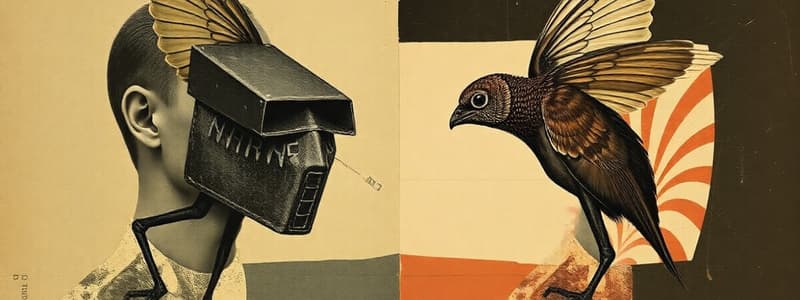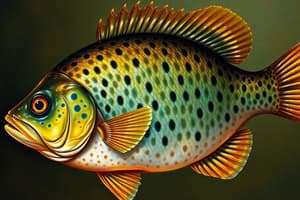Podcast
Questions and Answers
In Tungara frogs, the intersexual selection process is primarily driven by what factor?
In Tungara frogs, the intersexual selection process is primarily driven by what factor?
- Competition among male frogs for access to breeding sites.
- Male frogs selecting mates based on size.
- Female frogs choosing mates based on specific traits that may indicate higher energy expenditure. (correct)
- Predators preferentially targeting male frogs with elaborate display traits.
Which of the following outcomes is LEAST likely to occur as a direct result of intrasexual selection?
Which of the following outcomes is LEAST likely to occur as a direct result of intrasexual selection?
- Development of sperm competition mechanisms.
- Evolution of larger body size in males for combat.
- Heightened male investment in mating opportunities.
- Increased female choice based on elaborate male displays. (correct)
What is the significance of 'honest indicators' in the context of sexual selection?
What is the significance of 'honest indicators' in the context of sexual selection?
- They reduce the risk of predation for displaying males.
- They are chosen randomly and have no impact on mate selection.
- They are reliable signals of a male's genetic quality or resources. (correct)
- They are traits that males use to deceive females into mating.
In the context of speciation, what is the primary role of reproductive isolation?
In the context of speciation, what is the primary role of reproductive isolation?
What is the key distinction between allopatric and sympatric speciation?
What is the key distinction between allopatric and sympatric speciation?
Which of the following scenarios is an example of post-zygotic isolation?
Which of the following scenarios is an example of post-zygotic isolation?
What does 'descent with modification' refer to?
What does 'descent with modification' refer to?
Which factor distinguishes analogous structures from homologous structures?
Which factor distinguishes analogous structures from homologous structures?
Which concept is central to the study of phylogenies?
Which concept is central to the study of phylogenies?
What is the purpose of using an outgroup when constructing a phylogenetic tree?
What is the purpose of using an outgroup when constructing a phylogenetic tree?
What is the primary focus of the field of biogeography?
What is the primary focus of the field of biogeography?
What does the theory of island biogeography primarily explain?
What does the theory of island biogeography primarily explain?
Which of the following is a key outcome of adaptive radiation?
Which of the following is a key outcome of adaptive radiation?
What role does key innovation play in adaptive radiation?
What role does key innovation play in adaptive radiation?
What is the significance of homeotic (HOX) genes in evolutionary developmental biology (evo-devo)?
What is the significance of homeotic (HOX) genes in evolutionary developmental biology (evo-devo)?
In evo-devo, how can changes in the timing of developmental processes (heterochrony) lead to evolutionary change?
In evo-devo, how can changes in the timing of developmental processes (heterochrony) lead to evolutionary change?
What is the primary function of enhancers in gene regulation?
What is the primary function of enhancers in gene regulation?
What does deep homology suggest about the evolution of complex traits?
What does deep homology suggest about the evolution of complex traits?
Why is understanding the distinction between homology and homoplasy important in evolutionary biology?
Why is understanding the distinction between homology and homoplasy important in evolutionary biology?
Which situation would favor pre-zygotic isolation?
Which situation would favor pre-zygotic isolation?
Flashcards
Sexual Dimorphism
Sexual Dimorphism
Differences in phenotype developed in one sex, not driven by adaptation.
Intrasexual Selection
Intrasexual Selection
Competition among individuals of the same sex for access to mates.
Intersexual Selection
Intersexual Selection
Selection where mates are chosen based on specific traits.
Darwin's First Theory
Darwin's First Theory
Signup and view all the flashcards
Darwin's Second Theory
Darwin's Second Theory
Signup and view all the flashcards
Migration
Migration
Signup and view all the flashcards
Gene Flow
Gene Flow
Signup and view all the flashcards
Species Delimitation
Species Delimitation
Signup and view all the flashcards
Reproductive Isolation
Reproductive Isolation
Signup and view all the flashcards
Evolution
Evolution
Signup and view all the flashcards
Species Formation
Species Formation
Signup and view all the flashcards
Allopatric Speciation
Allopatric Speciation
Signup and view all the flashcards
Sympatric Speciation
Sympatric Speciation
Signup and view all the flashcards
Ecological Speciation
Ecological Speciation
Signup and view all the flashcards
Prezygotic Isolation
Prezygotic Isolation
Signup and view all the flashcards
Postzygotic Isolation
Postzygotic Isolation
Signup and view all the flashcards
Phylogenetics
Phylogenetics
Signup and view all the flashcards
Derived Characteristic
Derived Characteristic
Signup and view all the flashcards
Adaptive Radiation
Adaptive Radiation
Signup and view all the flashcards
Key Innovation
Key Innovation
Signup and view all the flashcards
Study Notes
Sexual Selection & Dimorphism
- Phenotypic diversity develops in one sex, not as an adaptation.
- Males often exhibit elaborate, costly secondary sexual characteristics that involve energy expenditure.
- These characteristics can increase risk of predation.
- Sexual selection is costly and involves breeding.
Intrasexual Selection
- Intrasexual selection happens when males compete
- Male combat occurs pre-mating, relates to body size
- Sperm competition occurs post-mating with different kinds of sperm, blockers, and plugs interacting.
- Males invest in mating opportunities.
- Male reproductive success is limited by access to fertile mates.
- Male competitiveness increases when there are many females.
- Females invest directly in offspring production, which is costly.
- Females often only mate once after fertilization.
- Females produce fewer, larger gametes, which is energetically costly (EXTERNAL FERT)
- Female success is limited by mate access; they choose for quality offspring.
- Deep competitions result in males competing for less common females.
- Female choice limits the number of mating opportunities.
Tungara Frogs
- Male courtship call consists of a whine and chucks.
- More chucks in a call indicate higher fitness, more attractive to female frogs, and more predators
- Intersexual selection is based on female choice where mates are selected based on specific traits that signal males' energy expenditure.
Darwin's Theories
- Darwin's Second Theory focuses on sexual selection
- Morphology relates to phenotypes associated with courtship and reproduction - maximizes reproductive success and evolutionary force
- Phenotypes with greater reproductive success gain greater ability to acquire mates.
- These phenotypes will remain even if they decrease survivorship if they still increase ability to mate and make more offspring.
- Sexual selection is not related to adaptation or survival
- Darwin's First Theory focuses on natural selection
- Natural selection explains how organisms adapt to their environment through modifications acquired from a common ancestor.
- Adaptive significance links to Mendelian inheritance and population genetics using the Modern Synthesis view.
- Natural selection explains how modifications increase an animal's ability to survive and reproduce.
- Phenotypes with greater survival ability lead to a more adapted population.
Sexual Selection: Female Choice
- Females select males who provide the best alleles using "honest indicators."
- Male display traits can hyper-stimulate females into making poor mate choices.
- Females evolve to ignore exaggerated male traits.
- Evolution of female choice considers direct benefits like increased fecundity with male contribution and resources.
- Good genes increase genetic quality of offspring.
- Runaway sexual selection has preference linked to traits, while genetics for traits are inherited alongside genetics for preference.
- Sensory exploitation involves exploiting pre-existing sensory biases; females prefer things that resemble orange fruit and therefore love orange males.
Speciation
- Speciation requires migration
- The movement of individuals between two populations facilitates gene flow and the movement of alleles between two populations
- Species delimitation uses methods to define species.
- Reproduction isolation must be due to genetic differences
- Intrinsic barriers limit gene flow.
- Barriers to gene flow are expressed through key features of the mating system
- Barriers to gene flow are expressed through ecological characteristics (preference),
- Prezygotic isolation occurs when hybrid zygotes do not form because sperm doesn't meet egg.
- Developmental pathways can cause infertile hybrid offspring.
- Post zygotic isolation includes isolating mechanisms after zygote forms, which results in dead or infertile offspring.
- Two groups of organisms that do not produce offspring together may not mate because they don't see each other, are incompatible, or mate but produce infertile/not viable offspring.
Speciation Mechanisms
- Speciation mechanisms produce different species delimitation conclusions from different analyses.
- Changes in allele frequencies within a population drive evolution.
- Factors that limit gene flow between populations allow two populations to evolve in different trajectories, resulting in two different species.
- Species follow independent evolutionary trajectories, creating a boundary to the spread of alleles.
- In species formation, gene flow is reduced or interrupted.
- Populations diversify and reproductive isolation arises leading to speciation.
- Mechanisms of isolation shows biogeography defining species edges by a geographic boundary which describes species distributions.
Allopatric Speciation
- The Mayr model requires physical isolation as the first step in speciation.
- Vicariance splits one population into two, while dispersal is when a subset of the population moves to a new area
- Genetic drift occurs as populations migrate.
- Gene flow allele frequencies will stay the same.
- Barriers to migration arises and allele frequency changes because of genetic drift.
- Changes in allele frequencies result in genetic drift being interrupted.
- Alleles fix gradually in populations making populations slowly diverse.
- Differences accumulate by chance at loci controlling mating preference, resulting in assortative mating and reproductively isolated populations.
- If a barrier disappears, two populations can mix but assertive mating occurs and prevents interbreeding. This causes sister species to evolve separately.
- Only geographical isolation and time are required not necessarily natural selection for species to form.
- Fixed differences take a long time to build up and prevent two populations from interbreeding.
Differential Selection
- In differential selection, two species in different environments that are in close proximity have natural selection favoring environment-adapted individuals, which results in them being genetically different.
- Migration mixes alleles between populations, but natural selection won't produce environment-adapted populations when gene flow is high and species remain one species.
- By introducing a barrier and selecting for the environment, species evolve into different but well-adapted species.
- Sympatric speciation is divergence without isolation.
- Two populations become reproductively isolated within cruising range of each other.
- Assortative mating arises despite gene flow, without relying on genetic drift.
- Disruptive selection can lead to sympatric speciation causing a split in one population of generalists into two species of specialists.
- Ecological speciation is driven by selection and doesn't require any barriers to gene flow.
Incipient Speciation
- Incipient speciation applies to the maggot fly case study
- Incipient Speciation is at the early stages of speciation
- Apple maggot flies are 94% different and not yet fully separate.
Ecological Speciation
- Natural selection in different environments can be a more powerful evolutionary force than isolation over time.
- Disruptive selection on body size can vary: benthic species have big, slow bodies while limnetic species have small, fast bodies.
- Fish of similar sizes mated, making genetic similarity not important and resulting in size-assertive mating and reproductive isolation.
- There is no gene flow in two ecotypes (different forms of one species that has not yet evolved full reproductive isolation).
- Evolutionary force creates two ecotypes and species become reproductively isolated.
- Disruption + Ecological Speciation is controversial
How Ecotypes Become Reproductively Isolated
- Selection acts on a trait that confers reproductive isolation
- Ecotypes can become reproductively isolated by pleiotropy, also known as a "Two-for-one Trait"
- Habitat choice would cause the species to prefer to mate with those of the same habitat.
- Selection acts on a trait like size in organisms that showcase size-assortative mating
- Species under "seleceon" can become associated with a male display trait, acting as an honest indicator of fitness.
Pre and Post Zygotic Isolation
- Reproductive isolation can be pre or post zygotic
- Prezygotic isolation happens before sperm and egg fuse, is governed by mating behavior
- Prezygotic isolation includes habitat choice, time shift, time/space shift, mating rituals, size assortative mating for corals, salmons, and cicadas
- It also includes sperm behavior and gamete recognition proteins
- Postzygotic isolation is never favored by natural selection
- Postzygotic isolation happens when sperm meets the egg but the embryo fails to develop or develops but is sterile.
- Gradually and randomly fixing traits controlling mating behavior or genetic capacity controls genetic drift.
- Adaptive species are less likely to hybridize and have higher fitness hybrids selected against.
- Hybrids are less fit and sterile, so selection acts against adults so reproductive Isolation can happen
- Intermediary phenotypes are hybrids that are not as fit in pure bred habitats.
- Reinforcement includes selections against hybrid that contribute to assortative mating.
- Premating isolation is favored by selection when recently diverged species encounter each other.
- higher sympatry is closer clustered together.
- Two species running into each other will not mate because of sympathy for hybrids is low, and it remains at a prezygotic isolation level.
Phylogenetics and Systematics
- Phylogenetics reconstructs evolutionary history and studies the patterns within.
- Systematics studies the understanding of evolution, taxonomy, and phylogeny.
- Cladograms represent species from a single common ancestor and use shared derived characters that are informative.
- The use of parsimony occurs as well
Taxonomy and More
- Morphology, behavior, physiology, and DNA are recognizable character states.
- Plesiomorphy refers to the ancestral character state while apomorphy is a character state different than the ancestral or derived state.
- Evolutionary reversals are species that re-evolve characteristics of ancestral species.
- Derived characteristics are similarities inherited from the most recent common ancestor of the entire group.
- Ancestral characteristics arose prior to that common ancestor.
Phylogenies
- Synapomorphy is a derived character state that is shared by two or more taxa due to having a common ancestor.
- Autapomorphy is a uniquely derived character state.
- Homologous is a shared character between two DNA sequences or taxa and is inherited.
- Homoplasy has evolved independently.
- Monophyletic includes all descendants of the common ancestor and are known as clades.
- Non-monophyletic is any case that does not satisfy monophyletic.
- Polyphyletic groups are assemblages of taxa that have been erroneously grouped based on homoplasious characters like vultures.
- Herpetology is the study of amphibians and non-bird reptiles, which represents the study of a paraphyletic group that excludes mammals and birds.
- Homoplasy is parallel evolution involving independent evolution of the same feature from the same ancestral condition; and convergent evolution representing independent evolution from different conditions.
- Secondary loss is the reversion to ancestral conditions.
Phylogenies Convergence Cont'd
- Analogy represents fins of a whale or shark due to independent acquisition in different lineages; parallel represents large and small stickleback species.
Phylogenetic Tree
- Constructed using homologous characters in order to find synapomorphies
- Synapomorphies identify monophyletic group
- Applies simple explanations instead of complicated ones
- Less evolution is better than more
- Lease # of steps if the most parsimonious
- Outgroups are not part of the group of interest, but they also must not be too distantly related. this is done to polarize character states or infer change, the Character state possessed by outgroup is defined as a priori as ancestral
- The taxonomy basics are as follows: Super group > kingdom > phylum > class> order > family > genus > species
- Paraphyletic classification contains many taxonomic groups that were recognized by traditional taxonomy
- Phylogeography involves using phylogeny in order to understand geography
- Coevolution happens when evolution acts on different species together
Biogeography
- Biogeography integrates geology, paleontology, phylogenetics, and ecology.
- Geographic distribution factors include biotic factors, abiotic factors, dispersal, and vicariance.
- Biotic factors include adaptation, dispersal, and jump dispersal.
- Abiotic factors include climate regime change, eustatic events, and tectonic events.
- Dispersal happens when the taxon originated in one area and dispersed to other areas while vicariance is when areas were formerly continuous.
- Comparative phylogeography shows how historical processes have shaped the geographic distributions of genetic lineages. Phylogenetic trees used to compare patterns of genetic variation bw the different species that live in the same area.
- Congruent biogeographies identify historical biogeographic events and feature similar geographic patterns of genetic divergence across different species.
- Ecology: Species cannot survive outside physiological tolerance, biogeography cannot contradict ecology.
- Islands: Function of size of island and distance from mainland. Small islands have higher extinction rates, islands far have less immigration.
Islands
- Determining ecology and evolutionary
- Species can't occupy regions that don't exist
- History of island matters, as well as species
Islands and Adaptive Radiation
- Adaptive radiation helps the population evolve.
- Microevolution involves allele frequencies (mutations, nat selection, migrations)
- This includes: speciation, adaptation, and different species lineages
- Macroevolution consists of the lineages/clades of of species
- Evolutionary success is defined by # of living species
- Ecological opportunity describes the invasion of unutilized ecological niches
- Can lead to diversification or key innovation
- Character displacement restricts niches and/or phenotypes
- Rapid diversification is an adaptive rate of radiation, which can be caused by divergent evolution
- Adaptive radiation precipates divergent evolution in different species in various ecological niches
- Pollution clouded lake victoria
- Co-speciation is one plant and two insect species that shift and specialize
Adaptive Radiation Cont'd
- Adaptive Radiation can be demonstrated in beetles
- Australian marsupials also demonstrate adaptive radiation in the absence of competitive interractions
- Adaptive radiation is more likely to occur with an amniotic egg and feathers/wings
- Rapid diversification corresponds to major environmental change
- A lineages becomes a evolutionary winner through different niches and specialization
- Species with adaptation for both hot and cold temperatures survive
Morphologies
- Modern synthesis has morphological development
- Morphology expresses as gene products
- Body plans and limbs form this morphology
- Homeotic genes express cell location and determine fates
- Vertebrates have HOM genes
Tetrapod Gene
- The tetrapod limb develops from lobe genes
- Apical Ridge forms cells
- The cells express at the limb base
- Genes control all this
- Hox genes form limbs
- Appendage genes express
- Organisms express development and deep homology
Studying That Suits You
Use AI to generate personalized quizzes and flashcards to suit your learning preferences.




